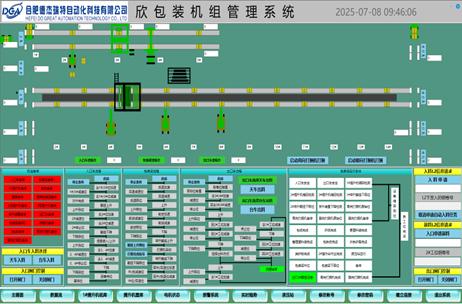
Packaging of the upper computer system
The packaging upper-level computer system serves as the digital control hub for the packaging process, with the core goal of visualizing equipment status and achieving precise operation. It builds an intelligent interaction bridge between operators and packaging equipment. The system deeply integrates the operation logic of packaging equipment. On one hand, it presents real-time information on equipment operation parameters (such as speed, pressure, temperature), working status (running / stopped / faulty), and process progress through dynamic interfaces, forming a digital mapping of the physical operation status of the equipment, allowing operators to globally control the equipment dynamics without on-site inspection. On the other hand, it integrates operation functions such as equipment start/stop, parameter adjustment, and mode switching, enabling remote intervention and precise control of the packaging process, and constructing a complete management loop from status perception to command execution.
The three core characteristics of this system highlight its critical value in the packaging scenario: The timeliness of equipment status display is the prerequisite for efficient response. Through millisecond-level data collection and interface refresh mechanisms, it ensures the synchronous presentation of critical information such as abnormal signals, parameter fluctuations, etc., allowing operators to detect potential faults at an early stage, significantly reducing emergency response time. The accuracy of operating equipment is a guarantee for safe production. The system uses preset operation logic, permission verification, and secondary confirmation mechanisms for instructions to avoid accidental touch and operation errors, ensuring that each instruction precisely corresponds to the equipment action, reducing the risk of production interruption caused by human error. The uniqueness of information interaction is the foundation of reliable data. The system adopts exclusive communication protocols and data encryption technologies, ensuring that each set of data has a unique identifier and verification mechanism in the information transmission with the equipment PLC and production management system, preventing information duplication, loss, or tampering, and providing a reliable basis for packaging data traceability and production scheduling.
In addition, by integrating equipment status monitoring and operation control, the system breaks through the bottlenecks of "information lag" and "coarse operation" in traditional packaging management. Operators can quickly locate equipment abnormal points and trace operation history through intuitive visual interfaces. Managers can analyze indicators such as equipment utilization rate and fault frequency through the system's accumulated operation data, providing data support for equipment maintenance and process optimization. Ultimately, the system's core capabilities of "real-time perception, precise control, and data fidelity" not only enhance the stability and safety of packaging equipment operation but also promote the packaging process from "experience-driven" to "data-driven", laying a solid foundation for equipment control in the intelligent production system.